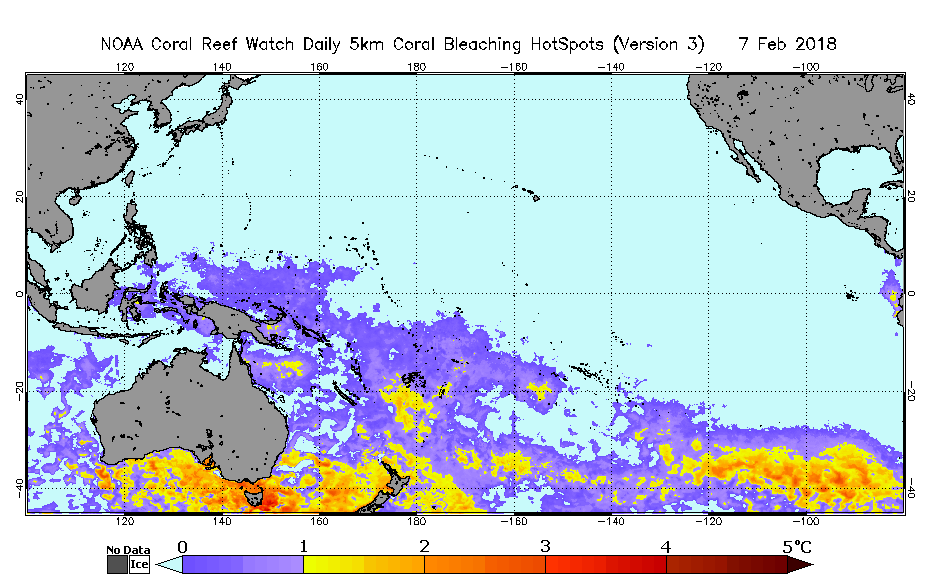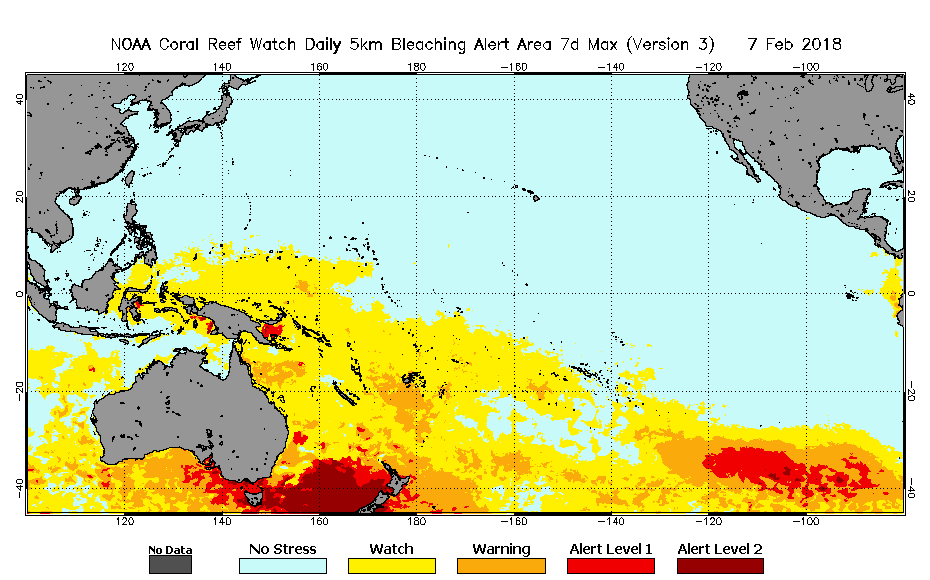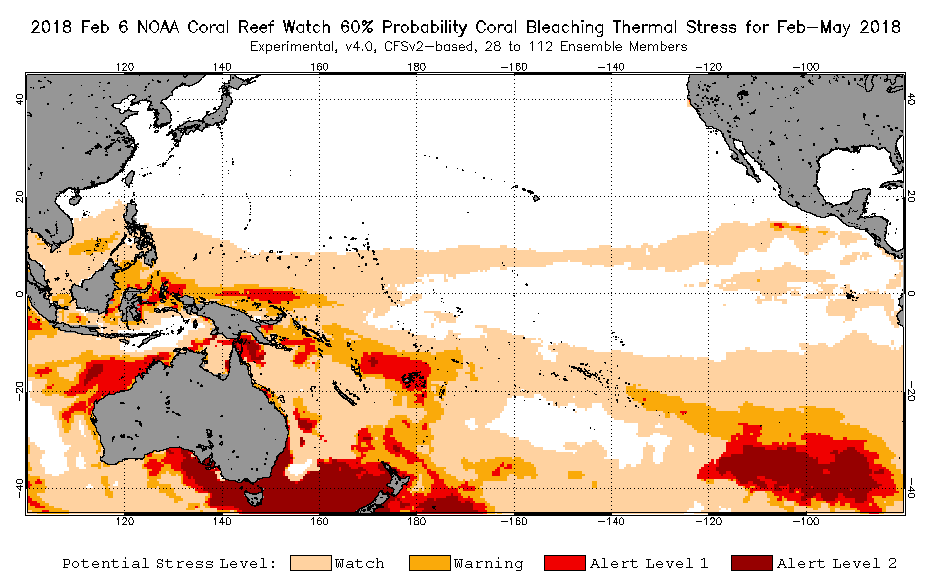Coral Bleaching Heat Stress Analysis and
Seasonal Guidance through May 2018
(Released February 8, 2018)
Current conditions:
NOAA Coral Reef Watch's (CRW) near-real-time satellite monitoring shows above-average sea surface temperatures (SSTs) in most of the western tropical Pacific Ocean. High SST anomalies (>1°C) extend from the Philippines, east through Palau and to the Federated States of Micronesia (FSM), and south through Vanuatu and Fiji to the Cook Islands (Figure 1). In contrast, a large swath of below-average SSTs, associated with the current La Niña, extends along the equator from the central to eastern Pacific Ocean. As of February 8, 2018, the NOAA National Centers for Environmental Prediction's El Niño-Southern Oscillation (ENSO) Alert System is at "La Niña Advisory" status. The La Niña is expected to continue through Northern Hemisphere winter and transition (~55% chance) to ENSO-neutral conditions during spring (March-May).

|
||
|
Figure 1. NOAA Coral Reef Watch's Satellite Sea Surface Temperature Anomaly product for the Pacific region. |
||
HotSpots have been diminishing in the Northern Hemisphere but continue to develop in the Southern Hemisphere (Figure 2). They are concentrated mainly between New Caledonia and Fiji and between Papua New Guinea and Australia's Great Barrier Reef (GBR). Minor bleaching has been reported in many areas of the GBR. Bleaching heat stress in the Coral Sea region has swung between Watch and Warning, with a few episodes of rapid SST increase followed by dramatic SST decrease since December 2017; this most likely was caused by major weather events. CRW's SST Anomaly and Coral Bleaching HotSpot products are quite elevated for Southeastern Australia and New Zealand. Along the western coast of Australia, few coral reef areas are experiencing stress levels above Bleaching Warning (Figure 3); the exception being Hamelin Pool, which currently is registering Alert Level 2. The rest of the Pacific has minimal heat stress.

|
||
|
Figure 2. NOAA Coral Reef Watch's Satellite Coral Bleaching HotSpot product for the Pacific region. |
||

|
||
|
Figure 3. NOAA Coral Reef Watch's Satellite Bleaching Alert Area (7-day maximum) product for the Pacific region. |
||
CRW's most recent Four-Month Coral Bleaching Outlook (Figure 4) projects continued heating (to Alert Level 1) around Fiji and the northernmost portion of the GBR, around the Torres Strait. The GBR should begin to cool down by mid-March 2018, while Fiji should see its warmest temperatures in April. The remainder of the Pacific should stay at low levels of heat stress; i.e., Bleaching Watch or No Stress.

|
||
|
Figure 4. NOAA Coral Reef Watch's Four-Month Coral Bleaching Heat Stress Outlook of February 6, 2018 for the period February-May 2018 for the Pacific region. |
||
NOTE: This report focuses on NOAA Coral Reef Watch's Version 3.0 (or v3) 5km satellite-based coral bleaching heat stress products and v4 Four-Month Coral Bleaching Heat Stress Outlook. The 5km satellite products presented here use CRW's newer color scales, which are implemented in the images posted on the CRW website.
To monitor the intensity and location of bleaching heat stress in your coral reef region of interest, please follow NOAA Coral Reef Watch's satellite monitoring and outlooks closely in the coming weeks: https://coralreefwatch.noaa.gov/satellite/bleaching5km/index.php and https://coralreefwatch.noaa.gov/satellite/bleachingoutlook_cfs/outlook_cfs.php.
CRW's current satellite and modeled products can be found at:
https://coralreefwatch.noaa.gov/satellite/index.php
CRW's Four-Month Coral Bleaching Heat Stress Outlooks can be found at:
https://coralreefwatch.noaa.gov/satellite/bleachingoutlook_cfs/outlook_cfs.php
CRW's 5km satellite Regional Virtual Stations can be found at:
https://coralreefwatch.noaa.gov/vs/index.php
Sign up for automated bleaching alert emails for CRW's 5km Regional Virtual Stations at:
http://coralreefwatch-satops.noaa.gov/
CRW's 50km satellite Virtual Stations can be found at:
https://coralreefwatch.noaa.gov/satellite/vs.php
Please report bleaching events (or non-events) at:
https://coralreefwatch.noaa.gov/satellite/research/coral_bleaching_report.php
Disclaimer
The content posted on this web page solely represents the opinions of the authors and does not constitute a statement of policy, decision, or position on behalf of NOAA or the US Government.
The appearance of external links on this World Wide Web site does not constitute endorsement by the Department of Commerce/National Oceanic and Atmospheric Administration of external Web sites or the information, products or services contained therein. For other than authorized activities, the Department of Commerce/NOAA does not exercise any editorial control over the information you may find at these locations. These links are provided consistent with the stated purpose of this Department of Commerce/NOAA Web site.